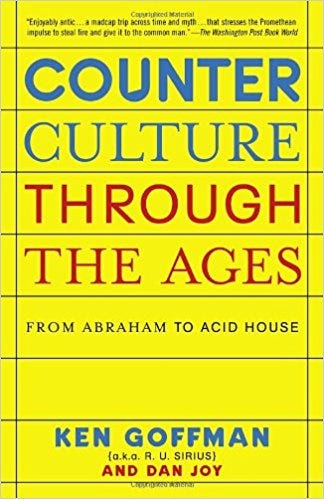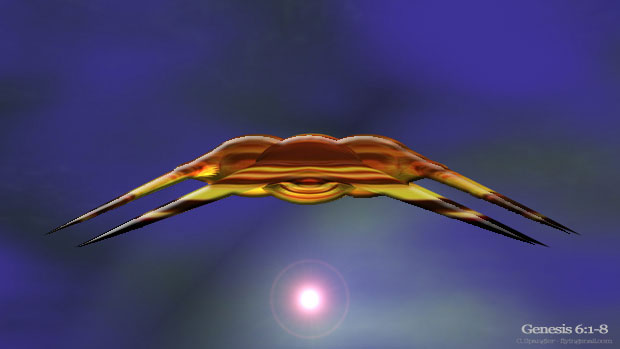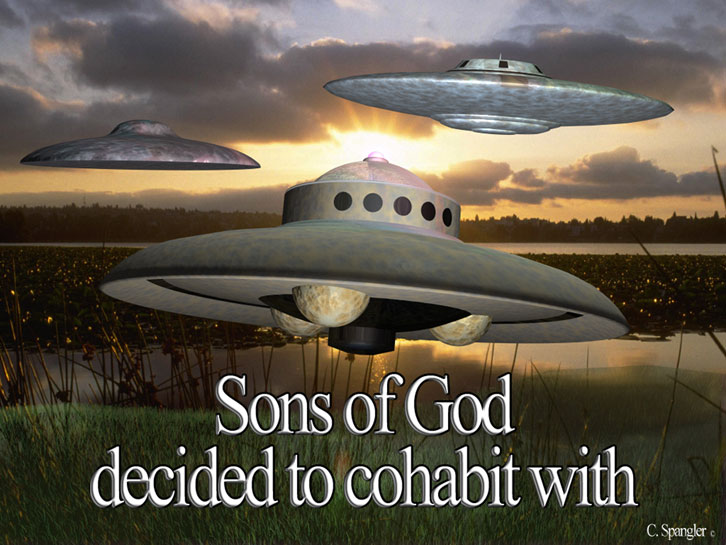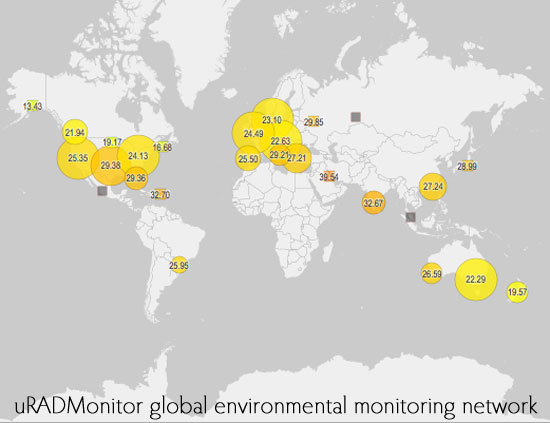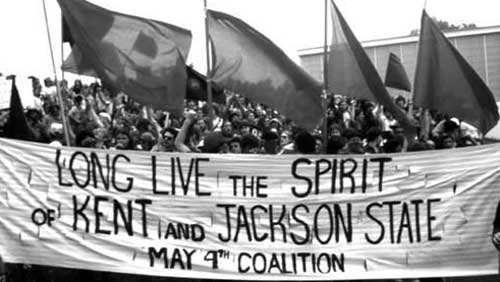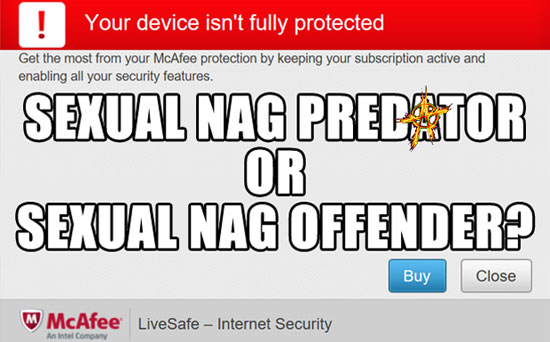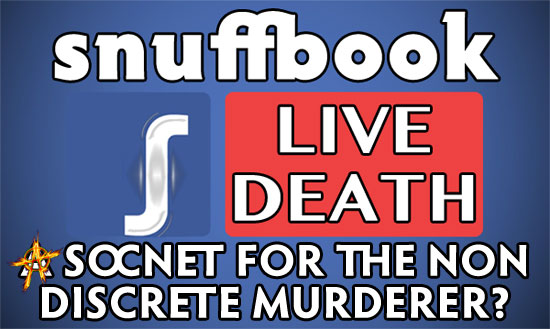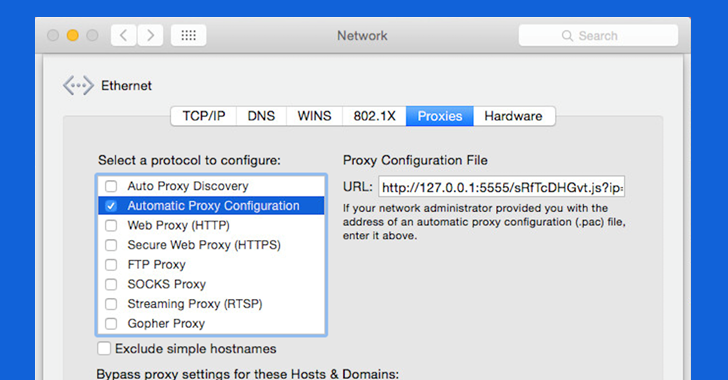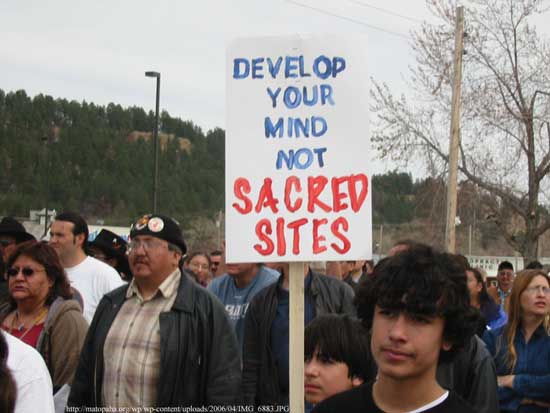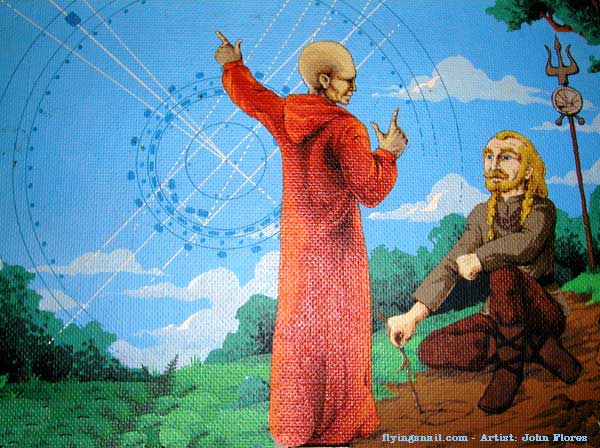Are law makers the greatest law breakers?
Too many email accounts have been compromised.
Convince me you are who you say you are. ~@~
The Nephilim were on the earth in those days—and also afterward—when
the sons of God went in to the daughters of humans, who bore children
to them. These were the heroes that were of old, warriors of renown.
I would like my American Bandstand Membership Cards back. ~@~
Operating Systems once costing $$$ are now free so Nobody can
complain about updates breaking stuff or un-removable advertisement.
And in the end, the love you take is equal to the love you make. ~ John Lennon
If Net Neutrality goes, so do we, and you'll need our PO BOX if you want to stay in contact.

Dreamstreets 26 with Even Steven
Dreamstreets 26 returns to WVUD 91.3 fm / www.WVUD.org every Tuesday afternoon at 2pm (EDT). This series mingles the work by current local poets and authors with the history of Delaware’s literature. On Tuesday’s first program you’ll hear about John Lofland, Delaware’s first notable literary artist and hear readings from his work. You’ll also hear about how American poet Walt Whitman and Edgar Allan Poe have left their mark on local poets and authors with readings from poet Douglas Morea and author Bob Davis, and well as a recording of Walt Whitman himself. ~ Steve
Dreamstreets 26: Tuesdays, 2 PM EDT, 11 AM PDT
Go To: http://www.wvud.org/?page_id=24
Click on a listening link below the WVUD logo:

People with creative personalities really do see the world differently
by Luke Smillie ~ Senior Lecturer in Personality Psychology, University of Melbourne and Anna Antinori ~ PhD candidate, University of Melbourne
@ The Conversation ++ Source ~ May 28, 2017 4.04pm EDTWhat is it about a creative work such as a painting or piece of music that elicits our awe and admiration? Is it the thrill of being shown something new, something different, something the artist saw that we did not?
As Pablo Picasso put it:
Others have seen what is and asked why. I have seen what could be and asked why not.
The idea that some people see more possibilities than others is central to the concept of creativity.
Psychologists often measure creativity using divergent thinking tasks. These require you to generate as many uses as possible for mundane objects, such as a brick. People who can see numerous and diverse uses for a brick (say, a coffin for a Barbie doll funeral diorama) are rated as more creative than people who can only think of a few common uses (say, for building a wall).
The aspect of our personality that appears to drive our creativity is called openness to experience, or openness. Among the five major personality traits, it is openness that best predicts performance on divergent thinking tasks. Openness also predicts real-world creative achievements, as well as engagement in everyday creative pursuits.
As Scott Barry Kaufman and Carolyn Gregoire explain in their book Wired to Create, the creativity of open people stems from a “drive for cognitive exploration of one’s inner and outer worlds”.
This curiosity to examine things from all angles may lead people high in openness to see more than the average person, or as another research team put it, to discover “complex possibilities laying dormant in so-called ‘familiar’ environments”.
Creative vision
In our research, published in the Journal of Research in Personality, we found that open people don’t just bring a different perspective to things, they genuinely see things differently to the average individual.
We wanted to test whether openness is linked to a phenomenon in visual perception called binocular rivalry. This occurs when two different images are presented to each eye simultaneously, such as a red patch to the right eye and a green patch to the left eye.
For the observer, the images seem to flip intermittently from one to the other. At one moment only the green patch is perceived, and at the next moment only the red patch – each stimulus appearing to rival the other (see illustration below).
Binocular rivalry task. Author providedIntriguingly, participants in binocular rivalry studies occasionally see a fused or scrambled combination of both images (see middle frame, above). These moments of “rivalry suppression”, when both images become consciously accessible at once, seem almost like a “creative” solution to the problem presented by the two incompatible stimuli.
Across three experiments, we found that open people saw the fused or scrambled images for longer periods than the average person. Furthermore, they reported seeing this for even longer when experiencing a positive mood state similar to those that are known to boost creativity.
Our findings suggest that the creative tendencies of open people extend all the way down to basic visual perception. Open people may have fundamentally different visual experiences to the average person.
Seeing things that others miss
Another well-known perceptual phenomenon is called inattentional blindness. People experience this when they are so focused on one thing that they completely fail to see something else right before their eyes.
In a famous illustration of this perceptual glitch, participants were asked to watch a short video of people tossing a basketball to one another, and to track the total number of passes between the players wearing white.
Try this out yourself, before reading further!
[Count the basketball passes between players in white.]During the video, a person in a gorilla costume wanders into centre stage, indulges in a little chest-beating, and then schleps off again. Did you see it? If not, you are not alone. Roughly half of the 192 participants in the original study completely failed to see the costumed figure.
But why did some people experience inattentional blindness in this study when others didn’t? The answer to this question came in a recent follow-up study showing that your susceptibility to inattentional blindness depends on your personality: open people are more likely to see the gorilla in the video clip.
Once again, it seems that more visual information breaks through into conscious perception for people high in openness — they see the things that others screen out.
Opening our minds: is more better?
It might seem as if open people have been dealt a better hand than the rest of us. But can people with uncreative personalities broaden their limited vistas, and would this be a good thing?
There is mounting evidence that personality is malleable, and increases in openness have been observed in cognitive training interventions and studies of the effects of psilocybin (the psychedelic compound in magic mushrooms).
Openness also increases for students who choose to study overseas, confirming the idea that travel broadens the mind.
But there is also a dark side to the “permeability of consciousness” that characterises open people. Openness has been linked to aspects of mental illness, such as proneness to hallucination.
So despite its appeal, there may be a slippery slope between seeing more and seeing things that are not there.
So, from different personalities emerge different experiences, but we should always remember that one person’s view is not necessarily better than another’s.
Psychology ~ Creativity ~ Vision ~ Openness ~ Personality
Leaked Documents Reveal Counterterrorism Tactic
Used At Standing Rock To “Defeat Pipeline Insurgencies”
by Alleen Brown, Will Parrish, Alice Speri
@ The Intercept ++ Source ~ May 27 2017, 5:04 a.m.A SHADOWY INTERNATIONAL mercenary and security firm known as TigerSwan targeted the movement opposed to the Dakota Access Pipeline with military-style counterterrorism measures, collaborating closely with police in at least five states, according to internal documents obtained by The Intercept. The documents provide the first detailed picture of how TigerSwan, which originated as a U.S. military and State Department contractor helping to execute the global war on terror, worked at the behest of its client Energy Transfer Partners, the company building the Dakota Access Pipeline, to respond to the indigenous-led movement that sought to stop the project.
Internal TigerSwan communications describe the movement as “an ideologically driven insurgency with a strong religious component” and compare the anti-pipeline water protectors to jihadist fighters. One report, dated February 27, 2017, states that since the movement “generally followed the jihadist insurgency model while active, we can expect the individuals who fought for and supported it to follow a post-insurgency model after its collapse.” Drawing comparisons with post-Soviet Afghanistan, the report warns, “While we can expect to see the continued spread of the anti-DAPL diaspora … aggressive intelligence preparation of the battlefield and active coordination between intelligence and security elements are now a proven method of defeating pipeline insurgencies.”
More than 100 internal documents leaked to The Intercept by a TigerSwan contractor, as well as a set of over 1,000 documents obtained via public records requests, reveal that TigerSwan spearheaded a multifaceted private security operation characterized by sweeping and invasive surveillance of protesters.
As policing continues to be militarized and state legislatures around the country pass laws criminalizing protest, the fact that a private security firm retained by a Fortune 500 oil and gas company coordinated its efforts with local, state, and federal law enforcement to undermine the protest movement has profoundly anti-democratic implications. The leaked materials not only highlight TigerSwan’s militaristic approach to protecting its client’s interests but also the company’s profit-driven imperative to portray the nonviolent water protector movement as unpredictable and menacing enough to justify the continued need for extraordinary security measures. Energy Transfer Partners has continued to retain TigerSwan long after most of the anti-pipeline campers left North Dakota, and the most recent TigerSwan reports emphasize the threat of growing activism around other pipeline projects across the country.
The leaked documents include situation reports prepared by TigerSwan operatives in North Dakota, South Dakota, Iowa, Illinois, and Texas between September 2016 and May 2017, and delivered to Energy Transfer Partners. They offer a daily snapshot of the security firm’s activities, including detailed summaries of the previous day’s surveillance targeting pipeline opponents, intelligence on upcoming protests, and information harvested from social media. The documents also provide extensive evidence of aerial surveillance and radio eavesdropping, as well as infiltration of camps and activist circles.
TigerSwan did not respond to a request for comment. Energy Transfer Partners declined to comment, telling The Intercept in an email that it does not “discuss details of our security efforts.” [Click to continue reading & view images]
Boptime with Even Steven + Legends of Wilmington Jazz
On Saturday’s Boptime we begin by going back to this day in 1963 with the Broadway musical No Strings, with lyrics and music from Richard Rodgers. We continue with music from this day in 1963 in the 7am (EDT) hour. After an episode of Rockabilly Ridge with Michael Ace in the 8am (EDT) hour, during which we’ll hear some choice hillbilly bop. It’s Beatlemania at 9am (EDT) from this day in 1965, including a couple of Delaware Rock & Roll Hall of Fame selections, and other selections from this day in that year. ~ Steve
Boptime: Saturday, 6 AM Eastern, 3 AM Pacific
Go To: http://www.wvud.org/?page_id=24
Click on a listening link below the WVUD logo:
Paul Krassner ~ The Realist, Writer, Comic, Investigative Satirist
OPERATION MINDFUCK WAS TOO SUCCESSFUL
R.U. Sirius Interviewed by Douglas Rushkoff (Part 1)“Sartre said hell is other people. Now, hell is other people’s tweets or posts. They just irritate the crap out of all of us. The feeling is mutual.”
On April 5, I was on Douglas Rushkoff’s Team Human radio show. We agreed to get the interview transcribed for possible publication somewhere.
I’ve decided that rather than trying to edit a truncated version to pitch to more popular websites, I’m just going to keep it conversational and run it here. Maybe less people will see it, but that’s ok. I get to say what I want.
I’ve added to my own spew as I edited. We hope you enjoy.
DOUGLAS RUSHKOFF: I came in contact with your work for the first time at a psychedelics conference in Los Angeles. Albert Hoffman and Laura Huxley [Aldous Huxley’s wife] were there. Timothy was there, and I think Ram Das and Ralph Metzner. It was the original psychedelics crowd.
And there were a bunch of issues of your first magazine, High Frontiers. And to me it was like a calling card from the future.
I was in my early 20’s, and your magazine was an amalgamation of everything that I had been interested in yet had never seen connected before: cultural, scientific, biological, cosmic, spiritual, and pharmacological advances, all in one place. How did physics and math and drugs and music and culture and transgender and cultural alchemy all end up considered part of the same strand of cultural information? How did you come up with that?
R.U. SIRIUS: In a way, it just came together in my head. I assumed that there were other people out there like me. Sort of like what Paul Krassner said about starting The Realist at the start of the ’60s. He put it out to meet the other aliens…
So this was a new generation of aliens.
And to me, the generational aspect of it was important. And the cultural aspect of it was important. Because even though I was from a generation that had a lot of hippies and deadheads and so on, we were also the people who created the cultures of punk and new wave. I was in my mid-twenties when all that came along and it was a refreshing blast to my pot-soaked mind.
So I was adapted for a very speedy, hyper, futuristic mentality by that, as well as by scientific ideas and psychedelic ideas and so forth.
And by the time we were doing High Frontiers in the mid-80s, one could clearly see the so-called digital revolution coming on, and one could be fairly optimistic about it… actually, radically over-optimistic. (laughter) So all these things just felt like the makings of a truly contemporary magazine.
DOUGLAS RUSHKOFF: High Frontiers really ran the full gamut of hallucinatory experiences. It was a flag in the sand. Leary had said, “Find the others.” And this was saying to a new generation, “Yes, there are others. These are our experiences.”
But then, you turned it into Reality Hackers and eventually Mondo 2000. It became the voice of this 21st century post-television, designer-reality society.
R.U. SIRIUS: Yeah, the Jetsons on DMT, as Mark Dery snarkily labeled it.
DOUGLAS RUSHKOFF: And then, by the early 1990’s, cyberdelic scene spawned a new cultural phenomenon … the early rave-club-kids. And that helped give it an aesthetic that was more pleasing to young people than the old Haight-Ashbury world of Wavy Gravy and tie-dye T-shirts.
R.U. SIRIUS: That’s true. But I have to say that’s where I was a bit of a crusty old rocker myself. I was never that enamored of the musical style, and I would always be the one leaving the rave at four in the morning rather than staying ’til dawn. But sure, it was an incredible flowering of a new kind of hedonic optimism that was very reminiscent of late ’60s hippie optimism.
DOUGLAS RUSHKOFF: I always blamed Wired magazine and the investment ethos for changing the internet from an anything-can-happen, new human-potential movement that was represented so well by MONDO 2000, into the same old expansion of capital through IPOs and digital companies. I hate to even term it like this, but what went wrong? Why didn’t we get the whole everything changing at once for the human better that we were all imagining up in the Berkeley hills in the MONDO 2000 living room?
R.U. SIRIUS: I thought material abundance would come faster. The plan — such as it was — was that ideas and content could be replicated infinitely and therefor couldn’t be hoarded and had to be shared… and this would be matched by molecular technology that would turn matter into data that also could be infinitely replicated. I think that was the underlying utopian narrative. So aside from the ideology of the market, which we didn’t necessarily share with Wired, there was the excess of techno-optimism. I have to say that there was always a dark undercurrent with Mondo though. Critics quote the first editorial that was very woo-woo, but after that, ambiguity and tongue-in-chic were watchwords.
Anyway, the logic was that replicability would lead to a collapse of the barriers — of the turnstiles — around what people want and need. And we would have a post scarcity society that would liberate people and allow them to be playful and creative and friendly. I mean, that was the hippieish or post-hippieish aspect of Mondo — “the machines of loving grace.” There was definitely an underestimation of the tenacity of greed and power baked in to the early issues. There was this Buckminster Fuller notion that the technology changes the situation materially and that humans would response rationally to that. That’s sort of a Marxist view too… or an element of it. So the technology failed, the people failed, and the system failed to live up to these fever dreams.
DOUGLAS RUSHKOFF: So we were heading for a Star Trek replicator reality, more than 3D printers?
R.U. SIRIUS: There was this vibe among people in the cyberculture of the ’90s that things would change very fast. Some of it was inchoate. Some of it was… ummm… less inchoate.
A lot of these emerging technological potentials like nanotechnology — we didn’t examine the timelines and the realities as closely as we might have. Somebody who spent some time with Al Gore while he was vice president told me he worried that the singularity was going to happen during his presidency! Obviously, neither of those things happened… but that was the sort of thing that was going around in technoculture. And capitalism was there and figured out how and when this online world could be useful and made it more banal. It turned things to crap and also performed some useful services. And that’s the conundrum that we’re stuck with now.
DOUGLAS RUSHKOFF: It feels as if capitalism is much more suited for the net than humans or culture are. You know, capitalism is abstract. Of the three factors of production — land, labor, and capital — capital is the only one that can expand infinitely. It’s not real.
R.U. SIRIUS: Yeah. We don’t even need to have any humans left for the stock market to go through the roof. It can all be done by AIs.
If you look at that famous Wired magazine issue about the so-called Long Boom — this idea in the late ’90s that it was all uphill from here — the greatest emphasis is on how the market … the stock market… NASDAQ and so forth would grow to these unthinkably awesome numbers. Improvements in the lives of humans were almost a footnote.
I almost got sold. If wealth became vast enough, it would actually trickle-down. Most everything would be given away for free to everybody. You’d somehow manage to buy a few dollars worth of stock and it’d explode into abundance — or at least that was the sort of capitalist theory of post-scarcity. That theory is certainly still out there, albeit far less popular.
DOUGLAS RUSHKOFF: The problem with capitalism is that we didn’t own these networks, so they started extracting more value than they were giving us. So do you think the main problem was capitalism taking over the net or were we not really ready culturally — or did we not have the consciousness — to do what the net was suggesting, to really connect with other people on this new level?
R.U. SIRIUS: It has as much to do with people as it does with capitalism. The masses, so to speak, came online. And the coming together of the global mind — or whatever idealistic metaphor from the cyber-90s we might use — did not prove to be as delightful as John Perry Barlow or whomever might have hoped. What we realized is that –- within the terrain of disembodied minds — familiarity breeds contempt. And lots of death threats! I don’t want to know most people’s thoughts! Sartre said hell is other people. Now, hell is other people’s tweets or posts. They just irritate the crap out of all of us. The feeling is mutual.
DOUGLAS RUSHKOFF: I know. It’s almost as if internet users should have had some kind of a psychedelic training before they went online so they would be better prepared for this level of social interaction.
R.U. SIRIUS: It could help, although there are certainly plenty of intolerant psychedelic users online as well.
That’s a whole other area where I’ve become more critical… that whole thing about psychedelic people believing in bizarre stuff. I found it benign and amusing in the past, but it’s one of the consequences of the psychedelic revolution that I find far more irritating and consequential now.
Hippie culture is a folk culture. It’s pre-scientific and memes spread and take over fast. Suddenly everybody knows that the Rothchilds own everything and that there’s a magical hugging lady on tour.
DOUGLAS RUSHKOFF: I remember you and I bonded again 20 years later, shortly after 9/11, when some of the more extreme conspiracy theories were going around. We both took a lot of heat for not buying into them. I wrote a piece where I was arguing these were disinformants spreading these stories because they’re trying to keep us from seeing the simple basic truth of what had happened, which is horrible enough.
And it feels like 9/11 and the acceleration of conspiracy theory that it spawned, combined with the internet and the ability to connect anything to anything else, has yielded this bizarre world of ontological relativism that we’re in today where people can be so easily manipulated and drawn into these rabbit holes of false truths.
R.U. SIRIUS: Yeah, I’m sorry I blew up consensus reality, man. Operation Mindfuck was too successful. (laughter)
DOUGLAS RUSHKOFF: You take responsible for it!? Do you think the counterculture did this?
R.U. SIRIUS: Probably, yeah. If you follow some of the ideological discourse from people who are really influential in Russia, it’s postmodernism and Operation Mindfuck in the service of amoral raw power and political strategy. I know secondhand that there are people in Putin’s mindtrust who have read their Leary and their Discordianism and so forth and they are following a chaos strategy for disrupting the American consensus… or however you want to phrase the collapsing neoliberal order. And not collapsing towards a good end.
And I don’t mean to pin it all on the Russians. The contingency of truth — or the multiplicity of realities — is a great way to understand things existentially or ideologically, but it’s impinged too deeply into the area of actual news versus fake news and science denial. That’s probably what I mean when I say Operation Mindfuck has been too successful.
CONSERVATISM IS THE NEW COUNTERCULTURE? SO WHAT?
R.U. Sirius Interviewed by Douglas Rushkoff (Part 2)“Something like eight people control 50% of the world’s wealth. Weather disasters are set to kill and disrupt life on earth. But let’s argue about white chicks braiding their hair!”
On April 5, I was on Douglas Rushkoff’s Team Human radio show. We agreed to get the interview transcribed for possible publication somewhere.
I’ve decided that rather than trying to edit a truncated version to pitch to more popular websites, I’m just going to keep it conversational and run it here. Maybe less people will see it, but that’s ok. I get to say what I want.
I’ve added to my own spew as I edited. We hope you enjoy Part 2
DOUGLAS RUSHKOFF: Your book, Counterculture Through the Ages, shows not just the styles of counterculture through the ages but their function. And I’m wondering… is a counterculture even possible in a networked age? Or is humanity itself the counterculture in a digital environment?
R.U. SIRIUS: Actually, if you go back and look at the book, which came out in 2004, I asked, “is counterculture still counter anymore?” I questioned it both at the beginning and the end of the book. Without a consensus culture to play off of — and without the mutual parasitism that occurs when divergent transgressive moments rub up against a cultural consensus with enough rigidity to be said to exist — the discussion of counterculture becomes moot, which I think is the contemporary situation.
Alt-right types have been claiming to be the true counterculture of our times for several years. If you suppose that the global mainstream is pressuring you to embrace diversity, gay rights and so-called multiculturalism, then in order to transgress, you might become the opposite of those things. And there are some legitimate political questions surrounding that, although the solution is not to become racist or whatever just to rebel. There’s also an unfortunate element there of virtualized generations being alienated from the consequences of their play… or what they seem to take as being wickedly playful.
But there is the reality that huge ruling class corporations will boycott a town that passes a law that’s hostile to gays. There’s a neoliberal economic consensus that isn’t made uncomfortable by cultural politics. To the contrary, they’re happy to have people focused on it. You know, something like eight people control 50% of the world’s wealth. Weather disasters are set to kill and disrupt life on earth. Over a trillion dollars disappears into the surveillance industrial complex and nobody is tracking what it’s being used for (probably just lining pockets). But let’s argue about white chicks braiding their hair!
There’s some guy who has a very popular video saying conservatism is the new counterculture and my response mainly is that it’s moot. I’m not that interested in bragging about being counterculture anymore except maybe when it comes to music or something like that… to be outrageous and provocative within that context. In fact, my lyrics may qualify as trigger warningable… But within the context of politics and culture more broadly, I’m interested in what I can say and do that contributes to survival and advancement and I’m not going to worry about whether it’s counterculture or not.
R.U. Sirius Writer, editor, occasional talk show host & vocalist/lyricist. Steal This Singularity, MONDO 2000, Open Source Party, R.U. Sirius Shows, MONDO Vanilli…
GLOBAL BLACKOUT AGAINST
ANTI-NETFLIX LEGISLATIONComcast is trying to censor our pro-net neutrality website that calls for an investigation into fake FCC comments potentially funded by the cable lobby ~ Source
Fight for the Future has received a cease and desist order from Comcast’s lawyers, claiming that Comcastroturf.com - a pro-net neutrality site encouraging Internet users to investigate an astroturfing campaign possibly funded by the cable lobby - violates Comcast’s "valuable intellectual property." The letter threatens legal action if the domain is not transferred to Comcast’s control.
The notice is ironic, in that it’s a perfect example of why we need Title II based net neutrality protections that ban ISPs from blocking or throttling content.
If the FCC’s current proposal is enacted, there would be nothing preventing Comcast from simply censoring this site -- or other sites critical of their corporate policies -- without even bothering with lawyers.
The legal notice can be viewed here. It claims that Comcastroturf.com violates the Anticybersquatting Consumer Protection Act and infringes on Comcast’s trademarks. Of course, these claims are legally baseless, since the site is clearly a form of First Amendment protected political speech and makes no attempt to impersonate Comcast. (See the case "Bosley Medical Institute vs. Kremer" which held that a site critical of a company’s practices could not be considered trademark infringement, or the case Taubman vs. Webfeats, which decided that *sucks.com domain names—in this case taubmansucks.com—were free speech)
Comcastroturf.com criticizes the cable lobby and encourages Internet users to search the Federal Communication Commission (FCC)’s docket to check if a fake comment was submitted using their name and address to attack Title II based net neutrality protections. It has been widely reported that more than 450,000 of these comments have been submitted to the FCC -- and as a result of the site at Comcastroturf.com, Fight for the Future has heard from dozens of people who say that anti-net neutrality comments were submitted using their personal information without their permission. We have connected individuals with Attorneys Generals and have called for the FCC act immediately to investigate this potential fraud.
Companies like Comcast have a long history of funding shady astroturfing operations like the one we are trying to expose with Comcastroturf.com, and also a long history of engaging in censorship. This is exactly why we need net neutrality rules, and why we can’t trust companies like Comcast to just "behave" when they have abused their power time and time again.
Fight for the Future has no intention of taking down Comcastroturf.com, and we would be happy to discuss the matter with Comcast in court.
Updated: 201705.26
If Net Neutrality Dies, Comcast Can Just Block A
Protest Site Instead Of Sending A Bogus Cease-And-Desistfrom the comcastic dept
Trademark by Mike Masnick Tue, May 23rd 2017 3:00pm
techdirt source: Permalink ~ techdirt source: Short link
It appears that a vendor working for Comcast sent a totally bullshit cease-and-desist letter regarding a pro-net neutrality site: Comcastroturf.com, created by our friends over at Fight for the Future. The Comcastroturf website was set up as a tool to see if someone filed bogus FCC comments in your name. As you probably recall, there is a bot that has been flooding the FCC comment site with bogus anti-net neutrality comments, filed in alphabetical order. Reporters contacted some of the individuals whose names appear on these comments, and they had no idea what it was about. People are still trying to track down who is actually responsible for the bogus comments, but Fight for the Future set up this neat site to let you check if your name was used by whoever is behind it.
And, of course, the name "Comcastroturf" is pretty damn clever, given the topic. Kudos to Fight for the Future for coming up with that one. It is, of course, totally legal to use the domain name of a company that you're protesting in your own domain. There are numerous cases on this issue, normally discussed as the so-called "Sucks Sites." There's clearly no legal issue with Comcastroturf, and any reasonably informed human being would know that. Unfortunately, it would appear that Comcast hired a company that employs some non-reasonably informed humans.
The cease-and-desist letter was sent by a company called "Looking Glass Cyber Solutions" (no, really), which used to be called "Cyveillance" (only marginally less bad). We've written about Cyveillance twice before -- and both times they were about totally bogus takedown requests from Cyveillance that caused serious problems. The most recent was the time that Cyveillance, working for Qualcomm, filed a bogus DMCA notice that took down Qualcomm's own Github repository. Nice move. The earlier story, however was in 2013, and involved Cyveillance -- again representing Comcast -- sending a threatening takedown demand to some more of our friends over at TorrentFreak, claiming (ridiculously) that public court filings were Comcast's copyright-covered material, and threatening serious legal consequences if it wasn't taken down. Eventually, Comcast stepped in and admitted the cease-and-desist was "sent in error." You'd think that maybe this would have caused Comcast to think twice about using Cyveillance for such things. But, nope.
The rebranded Looking Glass Cyber Solutions has told Fight for the Future that "Comcastroturf" violates Comcast's "valuable intellectual property rights" and that failure to take down the site may lead to further legal action around cybersquatting and trademark violations. (Update: Turns out it wasn't a "rebranding" but Looking Glass bought Cyveillance...).
Of course, there's no way that Comcast would actually move forward with any legal action here. In fact, I'm pretty sure it already regrets the fact that the numbskulls at this vendor they hired to police their brand online just caused (yet another) massive headache for their brand online. Maybe, this time, Comcast will finally let Cyveillance/Looking Glass Cyber go, and find partners who don't fuck up so badly. Meanwhile, the fact that Looking Glass Cyber can't even figure out that Comcastroturf is a perfectly legal protest site makes the company's website -- which is chock full of idiotic buzzwords about "threat mitigation" and "threat intelligence" -- look that much more ridiculous. The only "threat" here is Looking Glass/Cyveillance and their silly cluelessness sending out censorious threats based on what appears to be little actual research.
Of course, without true net neutrality, if Comcast really wanted to silence Comcastroturf, it would just block everyone from accessing the site...
[Document image located at site]
Filed Under:
cease and desist, comcastroturf, cybersquatting, net neutrality, takedownCompanies:
comcast, cyveillance, fight for the future, looking glass cyber solutions
Dahbud Mensch ~ Stuck in the middle with WHO ? ~ News Worth Repeating
SEC
Beat the Demise of Net Neutrality
SCRAP ELECTRONIC CRAPWhat did you do before cell phones, pads, pods, and Internet?
Was it having more fun at less expense?Anti-Netflix
LegislationBrought to You by
Minister of Satan Politicians?A Note from twerking_nine2five
I feel like a key problem with rallying for net neutrality is the sheer amount of people that don't understand what it is or how it works.
It also doesn't help that the media doesn't care too much about presenting it (as television corporations are typically against it).
I think net neutrality, or rather the repeal of net neutrality needs rebranding.
In order for people to care, they need to realize what repealing net neutrality actually does. If we start referring to those who do not support net neutrality as people that are anti-Netflix, or anti-YouTube, and can make one of those the coloquial term, the general populace may start to care.
It needs to be taken a step further though, the American people need to realize that taking away net neutrality is in fact a method of limiting free speech. It could be called "anti-Netflix" legislation or "pay-per-speak" legislation.
People need to be aware that this is not a matter of politics. Whether they identify as a democrat, republican, or any number of the minority parties, this is something that can be used to limit free speech.
Steps to help:
1). Learn the analogy of roads to explain net neutrality
2). Explain the corporate motivation for ending net neutrality
3). Refer to it as "anti-Netflix" or "pay-per-speak" legislation
4). Explain that you believe Internet access is the same as any utility, and not a luxury service
Organization and awareness are the only way we can say net neutrality. If we can form a movement that defines net neutrality and promotes it, we may just be able to save it once more.
A Large Cup of Tears?
SOPA, PIPA, CISPA, ACTA, TPP, ITU,
CISPA again, TAFTAWe won them all. In 2015 Net Neutrality, for free access to our Internets. The FCC just signalled the death knell for that hard-won fight. We need to have a serious conversation and fight this, and time is short. Let's have that conversation.
Via /u/vriska1:
https://www.fightforthefuture.org/
https://www.publicknowledge.org/
You can set them as your charity on https://smile.amazon.com/
Write your House Representative and Senators
FCC: https://www.fcc.gov/about/contact
Add a comment to the repeal here
https://www.fcc.gov/ecfs/search/filings
An easier URL you can use thanks to John Oliver ~ www.gofccyourself.com
Major tech companies for Net Neutrality (open in incognito mode to skip wall),
and Senate Democrats for Net Neutrality.
Use this to help contact Congress & Senate:
https://resistbot.io/ ~~ https://democracy.io/#!/
Please don't feel powerless. I'd encourage all Americans to
Keep the Net Neutral from McKenna Fryman
Aldous Huxley: The Ultimate Revolution
Notes from ~@~
Facebook and Twitter ‘harm
young people’s mental health’Poll of 14 to 24-year-olds shows Instagram, Facebook, Snapchat and Twitter increased feelings of inadequacy and anxiety
Denis Campbell, Health Policy editor, May 19, 2017, Article Source
Four of the five most popular forms of social media harm young people’s mental health, with Instagram the most damaging, according to research by two health organisations.
Instagram has the most negative impact on young people’s mental wellbeing, a survey of almost 1,500 14- to 24-year-olds found, and the health groups accused it of deepening young people’s feelings of inadequacy and anxiety.
The survey, published on Friday, concluded that Snapchat, Facebook and Twitter are also harmful. Among the five only YouTube was judged to have a positive impact.
The four platforms have a negative effect because they can exacerbate children’s and young people’s body image worries, and worsen bullying, sleep problems and feelings of anxiety, depression and loneliness, the participants said.
Related: Social media and bullying: how to keep young people safe online
The findings follow growing concern among politicians, health bodies, doctors, charities and parents about young people suffering harm as a result of sexting, cyberbullying and social media reinforcing feelings of self-loathing and even the risk of them committing suicide.
“It’s interesting to see Instagram and Snapchat ranking as the worst for mental health and wellbeing. Both platforms are very image-focused and it appears that they may be driving feelings of inadequacy and anxiety in young people,” said Shirley Cramer, chief executive of the Royal Society for Public Health, which undertook the survey with the Young Health Movement.
She demanded tough measures “to make social media less of a wild west when it comes to young people’s mental health and wellbeing”. Social media firms should bring in a pop-up image to warn young people that they have been using it a lot, while Instagram and similar platforms should alert users when photographs of people have been digitally manipulated, Cramer said.
The 1,479 young people surveyed were asked to rate the impact of the five forms of social media on 14 different criteria of health and wellbeing, including their effect on sleep, anxiety, depression, loneliness, self-identity, bullying, body image and the fear of missing out.
Instagram emerged with the most negative score. It rated badly for seven of the 14 measures, particularly its impact on sleep, body image and fear of missing out – and also for bullying and feelings of anxiety, depression and loneliness. However, young people cited its upsides too, including self-expression, self-identity and emotional support.
YouTube scored very badly for its impact on sleep but positively in nine of the 14 categories, notably awareness and understanding of other people’s health experience, self-expression, loneliness, depression and emotional support.
However, the leader of the UK’s psychiatrists said the findings were too simplistic and unfairly blamed social media for the complex reasons why the mental health of so many young people is suffering.
Prof Sir Simon Wessely, president of the Royal College of Psychiatrists, said: “I am sure that social media plays a role in unhappiness, but it has as many benefits as it does negatives.. We need to teach children how to cope with all aspects of social media – good and bad – to prepare them for an increasingly digitised world. There is real danger in blaming the medium for the message.”
Young Minds, the charity which Theresa May visited last week on a campaign stop, backed the call for Instagram and other platforms to take further steps to protect young users.
Tom Madders, its director of campaigns and communications, said: “Prompting young people about heavy usage and signposting to support they may need, on a platform that they identify with, could help many young people.”
However, he also urged caution in how content accessed by young people on social media is perceived. “It’s also important to recognise that simply ‘protecting’ young people from particular content types can never be the whole solution. We need to support young people so they understand the risks of how they behave online, and are empowered to make sense of and know how to respond to harmful content that slips through filters.”
Parents and mental health experts fear that platforms such as Instagram can make young users feel worried and inadequate by facilitating hostile comments about their appearance or reminding them that they have not been invited to, for example, a party many of their peers are attending.
May, who has made children’s mental health one of her priorities, highlighted social media’s damaging effects in her “shared society” speech in January, saying: “We know that the use of social media brings additional concerns and challenges. In 2014, just over one in 10 young people said that they had experienced cyberbullying by phone or over the internet.”
In February, Jeremy Hunt, the health secretary, warned social media and technology firms that they could face sanctions, including through legislation, unless they did more to tackle sexting, cyberbullying and the trolling of young users.
Related: Google Is Evil ~ CASHCPR [Citizens Against Second Hand Cellular Phone Radiation]
Boptime with Even Steven + Legends of Wilmington Jazz
On Saturday’s Boptime we begin by heading back to this day in 1953 with the original Broadway musical Hazel Flagg at 6am (EDT), with Bud Powell, Charles Mingus and Roy Haynes at the Club Kavakos in Washington, D. C. rounding out the hour. At 7am (EDT) we continue with music from this day in 1953, the #1 songs, along with what was playing in local movie houses to what was happening in the Korean War. At 8am (EDT) we move up to this day in 1959, with two hours jam-packed with music from this day in that year, along with the popular movies playing in the Wilmington area and other items that’ll give us a sense of those times. ~ Steve
BOPTIME: Saturday, 6 AM Eastern time, 3 AM Pacific time
Go To: http://www.wvud.org/?page_id=24
Click on a listening link below the WVUD logo:
Notes from ~@~
S2E11
S2E11 Alien Disclosure ~ Shadow Brokers
Notes from ~@~
uRADMonitor
global environmental monitoring network
uRADMonitor is a global environmental monitoring network made of several hardware devices that measure chemical and physical air pollutants in real time.These devices have Internet connectivity and share all data to the central server. This way we understand better the pollution factors and what we can do to limit them, to get a cleaner environment and a better life quality. The infrastructure is a verified , big data platform, that allows connecting new sensors to track more parameters for example for water or soil to complement the existing solution. ~ blog
Related:
PocketMagic ~ Where Technology meets magic on Global radiation monitoring network:
A few days ago I announced my intention of creating my first crowd-funded project, but I didn't tell you what was it about. Well, I'm planning quite a challenging project - to bring my uRADMonitor to a global scale, and create a network of distributed detectors, with data centralized on one server, so everyone, regardless of location can access radiation related data.
Larry Cochrane's Redwood City Public Seismic Network:
Last 24 Hours, All times are UTC/GMT
Redwood City Radiation Level Plots, Geiger Counter Information, Scintillator and Gamma-ray Spectrometer Information
Dahbud Mensch ~ Stuck in the middle with WHO ? ~ News Worth Repeating
Nobody Cares These Politicians Lied to
The People and Got Away With Murder?Read My Lips and Click to see who THEY are?
Dahbud Mensch ~ Stuck in the middle with WHO ? ~ News Worth Repeating
Media Blackout Over Lawsuit
Accusing DNC Of Rigging Primaries
by Sean Adl-Tabatabai, Editor-in-chief at Your News Wire , May 14, 2017, Article Source
The mainstream media continue to censor coverage of a looming DNC lawsuit that accuses the Democrat Party of rigging the 2016 primaries in favor of Hillary Clinton.
Since October 2016, when the lawsuit was issued, reporters and pundits have ignored a lawsuit that looks set to prove that the Democratic National Committee systemically rigged the primaries in order to ensure Hillary Clinton won over Vermont Senator Bernie Sanders.
The lawsuit was issued after shocking documents surfaced by hacker Guccifer 2.0 that shows the party and DNC chair Debbie Wasserman colluding “by hook or by crook” to make Sanders lose.
The class-action suit was filed in the U.S. District Court for the Southern District of Florida in October, accusing both the DNC and Wasserman Schultz of “intentional, willful, wanton, and malicious” conduct in violating Article 5, Section 4 of the DNC Charter.
Lifezette.com reports: They represent three classes of plaintiffs: donors to the DNC, donors to the Bernie Sanders campaign, and all registered Democrats — and they want their money back.
On April 25, the court held a hearing on a motion to dismiss, with the DNC’s lawyers arguing that the party has every right to pick candidates in back rooms.
“There’s no contractual obligation here … it’s not a situation where a promise has been made that is an enforceable promise,” DNC lawyer Bruce Spiva argued in court.
The major news organizations shunned the controversy and allowed it to slip into near-oblivion as they hammered President Trump.
An article published Saturday on the liberal progressive website Salon notes that the mainstream media “almost completely blacked out coverage of this lawsuit.”
A writer for the Observer wrote on Monday: “In large part, the mainstream media [have] not covered the lawsuit in the six months between the court’s initial hearings in October 2016 to its latest hearing on April 25, 2017.”
The revelation that the Democratic Party is fine with rigging elections, and has no qualms about lying to its members and pretending to be neutral, is certainly interesting news. But many in the media apparently didn’t want anyone to pay too much attention to this.
“For Sanders supporters, the lawsuit provides an opportunity for vindication for being cheated and attacked by the Democratic establishment,” Observer reporter Michael Sainato wrote. “Now, the DNC is on record arguing that its voters have no reason to trust it to maintain free and fair elections.”
“Spiva’s defense is blatant proof that despite the fact that the DNC fashions itself as the party of the people, it is openly and clearly an oligarchy — a fact also made clear by its use of superdelgates,” Salon writer Sophia McClennen wrote.
A WikiLeaks document dump also revealed that former interim DNC chair Donna Brazile appeared to favor Clinton when she leaked a Democratic primary debate question to Clinton in an email. Sanders supporters cried fowl. But the media largely spurned them in favor of dogging Trump.
“The elephant in the room for the DNC isn’t Trump or the GOP or Bernie bros or Russian hackers; it is its own elitist, corporatist, cronyist, corrupt system that consistently refuses to listen to the will of the people it hopes to represent,” McClennen wrote. "This all proves that the DNC has a serious problem not only with the democratic process but also with the very idea of representing the will of its constituents."
(sigh) Yeah, it was a dream... and ...a good one!
Dahbud Mensch ~ Stuck in the middle with WHO ? ~ News Worth Repeating
FedEx hit as NSA-linked
ransomware spreads around the worldBy ETHAN BARON | ebaron@bayareanewsgroup.com | Bay Area News Group
PUBLISHED: May 12, 2017 at 1:12 pm | UPDATED: May 13, 2017 at 3:06 amAmerican shipping giant FedEx has been hit in a ransomware attack spreading quickly around the globe and linked to hacked or leaked data from the U.S. National Security Agency.
FedEx confirmed early Friday afternoon that it was a victim of the attack, but disclosed few details.
“Like many other companies, FedEx is experiencing interference with some of our Windows-based systems caused by malware,” the firm said in a statement. “We are implementing remediation steps as quickly as possible. We regret any inconvenience to our customers.”
Ransomware is a computer virus that attacks a computer or system’s functionality, so the hackers deploying it can demand payment to restore the ability to operate.
Reports suggest that companies and institutions in at least 70 countries have been targeted by the “WannaCry” malware, including the U.K.’s National Health Service.
The ransomware has been hitting Microsoft Windows systems. Victims find their computers locked down, and receive a message demanding payment of $300 in Bitcoin digital currency, reports indicated.
“What’s turning out to look like a consorted massive ransomware attack hitting targets worldwide is at an unprecedented scale,” Simon Crosby, chief technology officer of Cupertino cybersecurity firm Bromium, said in a statement.
“The suspected syndicated attack is unique in that it’s not targeted at any one industry or region, and is using a particularly nasty form of malware that can move through a corporate network from a single entry point.”
Health care organizations, governments, police and fire departments and militaries are “massively vulnerable,” Crosby said.
“An attack could cripple the organization entirely.”
If victims of the attack start paying the ransom, that will encourage its spread, said Paul Calatayud, chief technology officer at Kansas cybersecurity company FireMon.
The WannaCry hack “appears to have used an NSA exploit known as ‘EternalBlue,'” product liability lawyer Creighton Magid of New York headquartered law firm Dorsey & Whitney said in a statement.
The EternalBlue hacking technique was unleashed online by hacker group Shadow Brokers, Magid said.
“Microsoft released a patch earlier this year to address the vulnerability, but it appears that a number of hospitals and other users have not applied the patch,” Magid said.
Microsoft said its engineers on Friday added “detection and protection” against the malware, and noted that the patch it released in March provides “additional protections” against it.
“Those who are running our free antivirus software and have Windows Update enabled, are protected,” a company spokesperson said. “We are working with customers to provide additional assistance.”
The Seattle tech giant released the patch March 14, a month before the Shadow Brokers dump, according to Russian cybersecurity firm Kaspersky Lab.
The U.K. National Health Service said in an online advisory that 16 of its organizations had been affected.
“This attack was not specifically targeted at the NHS and is affecting organisations from across a range of sectors,” the advisory said.
“At this stage we do not have any evidence that patient data has been accessed.”
The malware assault highlighted the need for the State of California to promote the growth of a “cyber-ready” workforce, said Silicon Valley Leadership Group vice-president of technology and innovation policy Peter Leroe-Muñoz.
Leroe-Muñoz brought more than 25 local companies to Sacramento on Wednesday to lobby legislators for state resources to be directed toward boosting students’ cybersecurity skills at all levels of higher education, from junior colleges to advanced education programs, he said.
The goal is to ensure that companies can stock their ranks with employees knowledgeable enough on cybersecurity to play a role in thwarting attacks, Leroe-Muñoz said.
Dahbud Mensch ~ Stuck in the middle with WHO ? ~ News Worth Repeating
This Is Not the Tragedy
You Are Looking For
Boptime with Even Steven + Legends of Wilmington Jazz
On the next Boptime we begin at 6am (EDT) with Dizzy Gillespie and his big band recorded live in Chester, Pennsylvania. [Unfortunately this segment of the program will not be streamed over our internet feed.] At 7am (EDT) we’ll present the first part of The Secret City of Jazz. At 8am (EDT) co-host Larry Williams will join us on Clifford’s Corner. Kitty Mayo has the day off due to Mothers Day obligations, but that won’t stop us from playing those rare jazz and R&B sides. ~ Steve
BOPTIME: Saturday, 6 AM Eastern time, 3 AM Pacific time
Go To: http://www.wvud.org/?page_id=24
Click on a listening link below the WVUD logo:
Dahbud Mensch ~ Stuck in the middle with WHO ? ~ News Worth Repeating
The GOP decides accurate weather forecasting and
hurricane tracking are luxuries America can’t affordRepublicans try to defund NOAA’s satellite program — just as climate change is making the weather much more extreme.
Let's get an extended weather forecast from a jittery, inconsistent, reddish brown rodent.By Michael Conathan, CAPAF’s new Director of Oceans Policy ~ ThinkProgress Source
Weather predictions were once a frequent punchline but have improved dramatically in recent years. More often than not you’ll need an umbrella if your local television channel or website of choice tells you to take one when you leave the house. But we could take a huge step back to the days when your dartboard had a reasonable chance of outpredicting Al Roker if House Republicans have their way with the 2011 federal budget.
The House of Representatives is debating the Full Year Continuing Resolution Act (H.R. 1) to fund the federal government for the remainder of fiscal year 2011. The Republican leadership has proposed sweeping cuts to key programs across the climate change, clean energy, and environmental spectrum. They have also decided that accurate weather forecasting and hurricane tracking are luxuries America can no longer afford.
The GOP’s bill would tear $1.2 billion (21 percent) out of the president’s proposed budget for the National Oceanic and Atmospheric Administration, or NOAA. On the surface, cutting NOAA may seem like an obvious choice. The FY 2011 request for the agency included a 16 percent boost over 2010 levels that would have made this year’s funding level of $5.5 billion the largest in NOAA’s history.
Even this total funding level, however, is woefully insufficient for an agency tasked with managing such fundamental resources as the atmosphere that regulates our climate, the 4.3 million square miles of our oceanic exclusive economic zone, the ecological health of coastal regions that are home to more than 50 percent of all Americans, response to environmental catastrophes including the Deepwater Horizon oil spill, and fisheries that employ thousands of Americans and annually contribute tens of billions of dollars to the national economy.
More than $700 million of the president’s proposed 2011 increase in NOAA funding would be tagged for overhauling our nation’s aging environmental satellite infrastructure. Satellites gather key data about our oceans and atmosphere, including cloud cover and density, miniscule changes in ocean surface elevation and temperatures, and wind and current trajectories. Such monitoring is integral to our weather and climate forecasting and it plays a key role in projections of strength and tracking of major storms and hurricanes””things most Americans feel are worth keeping an eye on.
In fact, NOAA has been making great strides in hurricane tracking. The average margin of error for predicting landfall three days in advance was 125 miles in 2009"”half what it was 10 years prior. This data translates into a higher degree of confidence among the public in NOAA’s forecasts, which means individuals will be more likely to obey an evacuation order. Further, since evacuating each mile of shoreline costs approximately up to $1 million, greater forecasting accuracy translates to substantial savings.
The United States needs these satellites if we’re to continue providing the best weather and climate forecasts in the world. The implications of the loss of these data far exceed the question of whether to pack the kids into snowsuits for the trip to school. The concern here is ensuring ongoing operational efficiency and national security on a global scale. In some cases it can literally become a question of life and death.
Consider the following numbers:
- The $700 billion maritime commerce industry moves more than 90 percent of all global trade, with arrival and departure of quarter-mile long container ships timed to the minute to maximize revenue and efficiency. Shipping companies rely on accurate forecasts to set their manifests and itineraries.
- Forecasting capabilities are particularly strained at high latitudes and shippers have estimated that the loss of satellite monitoring capabilities could cost them more than half a billion dollars per year in lost cargo and damage to vessels from unanticipated heavy weather.
- When a hurricane makes landfall, evacuations cost as much as $1 million per mile. Over the past decade, NOAA has halved the average margin of error in its three-day forecasts from 250 miles to 125 miles, saving up to $125 million per storm.
- Commercial fishing is the most dangerous profession in the country with 111.8 deaths per 100,000 workers. A fisherman’s most valuable piece of safety equipment is his weather radio.
- When disaster strikes at sea, polar-orbiting satellites receive emergency distress beacons and relay positioning data to rescuers. This resulted in 295 lives saved in 2010 alone and the rescue of more than 6,500 fishermen, recreational boaters, and other maritime transportation workers since the program began in 1982.
- Farmers rely on NOAA’s drought predictions to determine planting cycles. Drought forecasts informed directly by satellite data have been valued at $6 billion to 8 billion annually.
- NOAA’s volcanic ash forecasting capabilities received international attention last spring during the eruption of the Icelandic volcano, Eyjafjallaj¶kull. The service saves airlines upwards of $200 million per year.
- NOAA’s polar-orbiting satellites are America’s only source of weather and climate data for vast areas of the globe, including areas key to overseas military operations. Their data are integral to planning deployments of troops and aircraft””certain high-atmosphere wind conditions, for example, can prohibit mid-air refueling operations.
All of these uses will be compromised if the Republicans succeed in defunding NOAA’s satellite program. At least an 18-month gap in coverage will be unavoidable without adequate funding for new polar-orbiting satellites this year. More troubling, taking an acquisition program offline and then restarting the process at a later date would lead to cost increases of as much as three to five times the amount the government would have to spend for the same product today.
So here’s the choice: Spend $700 million this year for continuous service or $2 billion to $3.5 billion at some point in the future for the same equipment and a guaranteed service interruption.
Environmental satellites are not optional equipment. This is not a debate about whether we should splurge on the sunroof or the premium sound system or the seat warmers for our new car. Today’s environmental satellites are at the end of their projected life cycles. They will fail. When they do, we must have replacements ready or risk billions of dollars in annual losses to major sectors of our economy and weakening our national security.
That’s an ugly forecast. Tragically, it’s also 100 percent accurate.
— Michael Conathan is Director of Oceans Policy at American Progress.
Related Posts on Extreme Weather:
- Study: Global warming is driving increased frequency of extreme wet or dry summer weather in southeast, so droughts and deluges are likely to get worse
- Two seminal Nature papers join growing body of evidence that human emissions fuel extreme weather, flooding that harm humans and the environment
- As floods and extreme weather devastate the world, CBS News explains the link to global warming.
- The year of living dangerously. Masters: “The stunning extremes we witnessed gives me concern that our climate is showing the early signs of instability”;
Munich Re: “The only plausible explanation for the rise in weather-related catastrophes is climate change”- Stunning NOAA map of Tennessee’s 1000-year deluge
- Climate
Dahbud Mensch ~ Stuck in the middle with WHO ? ~ News Worth Repeating
Long Live the Spirit of Kent and Jackson State ~ May 4th CoalitionStudents Killed at Jackson State University
May 14, 1970
On this date in 1970, two Black students at Jackson State University were killed and many others injured by Jackson police. These killings were never as publicized as the Kent State shootings of four white students that had occurred only a few days earlier. It was a time of turmoil in campus communities across the country that were characterized by protests and demonstrations.
No college or university was left untouched by confrontations and continuous calls for change. At Jackson State College in Jackson, MS, there was the added issue of historical racial intimidation and harassment by white motorists traveling Lynch Street, a major thoroughfare that divided the campus and linked West Jackson to downtown. On May 14-15, 1970, Jackson State students were protesting these issues as well as the May 4, 1970 tragedy at Kent State University in Ohio.
The riot began around 9:30 p.m., May 14, when rumors were spread that Fayette, MS Mayor Charles Evers (brother of slain Civil Rights activist Medgar Evers) and his wife had been shot and killed. Upon hearing this rumor, a small group of students rioted. That night, several white motorists had called the Jackson Police Department to complain that a group of Blacks threw rocks at them as they passed along the stretch of Lynch Street that bisected the campus. The rioting students set several fires and overturned a dump truck that had been left on campus overnight.
Jackson firefighters dispatched to the blaze met a hostile crowd that harangued them as they worked to contain the fire. Fearing for their safety, the firemen requested police backup. The police blocked off the campus. National Guardsmen, still on alert from rioting the previous night, mounted Armored Personnel Carriers, The guardsmen had been issued weapons, but no ammunition. Seventy-five city policemen and Mississippi State Police officers, all armed, responded to the call. Their combined armaments staved off the crowd long enough for the firemen to extinguish the blaze and leave.
After the firemen left, the police and state troopers marched toward a campus women's residence, weapons at the ready. At this point, the crowd numbered 75 to 100 people. Several students allegedly shouted "obscene catcalls" while others chanted and tossed bricks at the officers, who had closed to within 100 feet of the group. The officers deployed into a line facing the students. Accounts disagree as to what happened next. Some students said the police advanced in a line, warned them, and then opened fire. Others said the police abruptly opened fire on the crowd and the dormitory. Other witnesses reported that the students were under the control of a campus security officer when the police opened fire.
Police claimed they spotted a powder flare and opened fire in self-defense on the dormitory only. The students scattered, some running for the trees in front of the library, but most scrambling for the Alexander Hall west end door. There were screaming and cries of terror and pain mingled with the noise of sustained gunfire as the students struggled to get through glass double doors. A few students were trampled. Others, struck by buckshot pellets or bullets, fell only to be dragged inside or left moaning in the grass.
When the order to ceasefire was given, Phillip Lafayette Gibbs, 21, a junior pre-law major and father of an 18 month-old son, lay dead. Across the street, behind the line of police and highway patrolmen, James Earl Green, 17, was sprawled dead. Green, a senior at Jim Hill High School in Jackson, was walking home from work at a local grocery store when he stopped to watch the action. Twelve other Jackson State students were struck by gunfire. The five-story dormitory was riddled by gunfire. FBI investigators estimated that more than 460 rounds struck the building, shattering every window facing the street on each floor. Investigators counted at least 160 bullet holes in the outer walls of the stairwell alone bullet holes that can still be seen today.
The injured students, many of whom lay bleeding on the ground outside the dormitory, were transported to University Hospital within 20 minutes of the shooting. But the ambulances were not called until after the officers picked up their shell casings, a U. S. Senate probe conducted by Senators Walter Mondale and Birch Bayh later revealed. The police and state troopers left the campus shortly after the shooting and were replaced by National Guardsmen. After the incident, Jackson authorities denied that city police took part.
Reference: http://aaregistry.org/historic_events/view/killings-jackson-state-university
The biographical dictionary of Black Americans by Rachel Krantz and Elizabeth A.Ryan
Copyright 1992, Facts on File, New York, NY ~ ISBN 0-8160-2324-7Jackson State killings
From Wikipedia, the free encyclopediaThe Jackson State killings occurred on Friday May 15, 1970, at Jackson State College (now Jackson State University) in Jackson, Mississippi. On May 14, 1970, a group were confronted by city and state police. Shortly after midnight, the police opened fire, killing two students and injuring twelve. The event happened only 11 days after National Guardsmen killed four students at Kent State in Ohio, which had first captured national attention. ~ [Click to continue reading]
Dahbud Mensch ~ Stuck in the middle with WHO ? ~ News Worth Repeating
Remembering Emma Goldman
June 15, 1869 ~ May 14, 1940
If I can't dance, I don't want to be in your revolution
Emma Goldman (June 27 [O.S. June 15] 1869 ~ May 14, 1940) has always been one of my heroes.
She has been described as -- among other things -- "the most dangerous woman in America" and was given credit for the phrase, "If I can't dance, I don't want to be in your revolution."
She was an anarchist known for her political activism, writing, and speeches. She played a pivotal role in the development of anarchist political philosophy in North America and Europe in the first half of the twentieth century.
Born in Kovno in the Russian Empire (present-day Kaunas, Lithuania), Goldman emigrated to the U.S. in 1885 and lived in New York City, where she joined the burgeoning anarchist movement in 1889. Attracted to anarchism after the Haymarket affair, Goldman became a writer and a renowned lecturer on anarchist philosophy, women's rights, and social issues, attracting crowds of thousands. She and anarchist writer Alexander Berkman, her lover and lifelong friend, planned to assassinate industrialist and financier Henry Clay Frick as an act of propaganda of the deed. Although Frick survived the attempt on his life, Berkman was sentenced to twenty-two years in prison. Goldman was imprisoned several times in the years that followed, for "inciting to riot" and illegally distributing information about birth control. In 1906, Goldman founded the anarchist journal Mother Earth.
In 1917, Goldman and Berkman were sentenced to two years in jail for conspiring to "induce persons not to register" for the newly instated draft. After their release from prison, they were arrested -- along with hundreds of others -- and deported to Russia. Initially supportive of that country's Bolshevik revolution, Goldman quickly voiced her opposition to the Soviet use of violence and the repression of independent voices. In 1923, she wrote a book about her experiences, My Disillusionment in Russia. While living in England, Canada, and France, she wrote an autobiography called Living My Life. After the outbreak of the Spanish Civil War, she traveled to Spain to support the anarchist revolution there. She died in Toronto on May 14, 1940, aged 70.
During her life, Goldman was lionized as a free-thinking "rebel woman" by admirers, and denounced by critics as an advocate of politically motivated murder and violent revolution. Her writing and lectures spanned a wide variety of issues, including prisons, atheism, freedom of speech, militarism, capitalism, marriage, free love, and homosexuality. Although she distanced herself from first-wave feminism and its efforts toward women's suffrage, she developed new ways of incorporating gender politics into anarchism. After decades of obscurity, Goldman's iconic status was revived in the 1970s, when feminist and anarchist scholars rekindled popular interest in her life. [Continue Reading]
Bloody Thursday ~ May 15, 1969 ~ Berkeley, California, as told by ~@~
May 15, 1969 - Bloody Thursday
Republicans, with Democrat Support, Authorize Murder of Students
Orders issued by Ronald W. Reagan & Richard M. Nixon
Peoples Park 1969 from mel zimmerYou have probably seen the above title posted here over the years and here is why.
Early on Thursday morning May 15, 1969, after returning from an "Angels of Light" party with Allen Ginsberg, who was into his "Home, Home, Home," harmonium, Blake phase, a friend and I drank what we thought was a half bottle of orange juice someone had left in the refrigerator.
Just as we were 'downing' the last gulp of juice, a boyfriend of one of the women at the house came into the kitchen and said, "Where did you get that juice from?"
As it turned out, the orange juice contained a quarter ounce of mescaline sulfate and we were on our way to being thoroughly dosed.
Seeing it was going to be one of those 'sunshine daydream' mornings, we headed down Telegraph Ave. toward UC Berkeley, where we would take a right at the clock tower, walk up to Tilden Park, and hang out at the lake for the day.
About one half block from the campus we heard, what sounded like, gun shots and saw a large group of screaming people running toward us. Not knowing what to do, we began running South with the crowd.
People's Park Photo: Kathryn Bigelow ~ Source: http://www.peoplespark.org/69gall4.htmlActivism
With exception of getting exposed to Berkeley, Cody's Books, Mario Savio, Free Speech Movement, Sexual Freedom League, KPFA during 1964, and later attending a few demonstrations Veterans took part in against U.S. involvement in Vietnam, I ended up into Peace & Love.
I am a Vietnam Veteran, with honorable discharge and recommendation, who volunteered to serve our country during war [or what we were led to believe was war] and ended up becoming more of a Hippy because I was over-educated, liked history, knew none of what was tried in the past worked without people getting hurt, and realized progress was directed in reviewing alternatives to "History Repeating Itself!"
Leading up to this picture story, it is very important to remember:
I WAS NOT AN ACTIVIST
or involved with activism in any way!I was too busy having Hippie fun and writing some of the first
major computer systems used on an IBM 360/20 (period).Click Bloody Thursday to continue reading
People's Park May 15, 1969 Photo Story
People's Park Photo: Dick Corten ~ Source: http://www.peoplespark.org/69gall8.htmlFollowing video contains reference to "Sunshine Daydream"
Sugar Magnolia, Grateful Dead from Dru Korab
Notes from ~@~
Happy 81st Birthday Wavy Gravy
(May 15th) Much Love, FlyingSnail & Friends
Wavy Gravy @ Flying Snail Ranch ~ Photograph by C. SpanglerWavy Gravy (born May 15, 1936) is an American entertainer and activist for peace, best known for his hippie appearance, personality and countercultural beliefs. His moniker (the name he uses day to day) was given to him by B.B. King at the Texas International Pop Festival in 1969. "It's worked pretty well through my life," he says, "except with telephone operators – I have to say 'Gravy, first initial W.
Nobody for President ~ NONE of the ABOVE should be a choice on voter ballots
It's the end of the world as we know it.. again
A brief history of Socialist Plots to end the American way of life
Pulitzer Prize-winning American political cartoonist Matt Wuerker; founding staff member of Politico.
Dahbud Mensch ~ Stuck in the middle with WHO ? ~ News Worth Repeating
I said NO !!!
Why are you trying to force yourself on me?
Notes from ~@~
The Answer Has Been Changed to NO.
Dahbud Mensch ~ Stuck in the middle with WHO ? ~ News Worth Repeating
What Corporate Media Is Ignoring?
Visit: One Venezuelan Pic A Day _and_ This Shit Needs to Stop!
Notes from ~@~
MLB vs. Profits Not People?
Gausman ejected after hitting Bogaerts in the 2nd inning. Source ~ Comments
Dahbud Mensch ~ Stuck in the middle with WHO ? ~ News Worth Repeating
God Save The Queen, Sex Pistols from dmitry
Rainbow Puddle ~ Stellar Light Shows
Makeba / Jain from Greg&Lio
Dahbud Mensch ~ Stuck in the middle with WHO ? ~ News Worth Repeating
Boptime with Even Steven + Legends of Wilmington Jazz
On Saturday’s Boptime we begin at 6am (EDT) with the Broadway musical Bells Are Ringing from this time in 1957, then round out the hour with selections from Sun Ra. More music from this day in 1957 continues in the 7am (EDT) hour, including a selection from Miss Calypso, aka the American poet Maya Angelou. At 8am (EDT) we revisit the My World episode from May 1973, when the Beatles did not break up, Jimi Hendrix did not die, and we get on the boat we missed in the actual world. We continue the 8am (EDT) hour though the late 1960s and early 1970s with the Delaware Rock & Roll Hall of Fame and selections from Friends of the Family aka the Enfields, the Fabulous Pharaohs, Snakegrinder and Television. At 9am (EDT) on The Club Baby Grand segment, we begin with a short tribute to the late Wilmington jazz musician Vernon James. We’ll hear some tunes from Sarah Vaughan accompanied by Clifford Brown, and one with Ernie Watts. Then Ernie Watts accompanying Diane Krall. We’ll also hear a selection from Etta Jones accompanied by Wilmington jazz vibraphonist Lem Winchester. ~ Steve
BOPTIME: Saturday, 6 AM Eastern time, 3 AM Pacific time
Go To: http://www.wvud.org/?page_id=24
Click on a listening link below the WVUD logo:
Dahbud Mensch ~ Stuck in the middle with WHO ? ~ News Worth Repeating
Kent State ~ May 4, 1970
Remembering Politicians Authorized
Murder of Innocent Students in Ohio
Kent State Truth Tribunal
Seeking Truth & Justice at Kent State
The Day that Changed AmericaOn May 4, 1970 the Ohio National Guard opened fire on unarmed students protesting America´s invasion of Cambodia. Four students were killed and nine were wounded. The incident triggered national outrage in a country already divided over the Vietnam War. In the days that followed more than four million students rose up in dissent across 900 campuses, generating the only nationwide student protest in U.S. history.
The Kent State shootings have never been thoroughly examined and no person or group has been held accountable for wrongdoing. Forty years later, family members of those killed have initiated the Kent State Truth Tribunal to preserve and honor the stories of those whose lives have been touched by this tragedy. Taking inspiration from British Prime Minister David Cameron´s apology for the Bloody Sunday killings on June 15, 2010, the KSTT seeks official acknowledgment of the 1970 Kent State shootings.
Kent State University, May 4, 1970 from SundroidKent State Anniversary Blues
In my book, Magic Mushrooms and Other Highs: From Toad Slime to Ecstasy, Freddy Berthoff described his mescaline trip at a Crosby, Stills, Nash and Young concert in the summer of 1970 when he was 15. “Earlier that spring,” he wrote, “the helmeted, rifle-toting National Guard came up over the rise during a peace-in-Vietnam rally at Kent State University. And opened fire on the crowd. I always suspected it was a contrived event, as if someone deep in the executive branch had said, ‘We’ve got to teach those commie punks a lesson.’” Actually, President Nixon had called antiwar protesters “bums” two days before the shootings. While Freddy was peaking on mescaline, CSNY sang a new song about the massacre:
Tin soldiers and Nixon coming
We’re finally on our own
This summer I hear the drumming
Four dead in O-hi-o…
Plus nine wounded. Sixty-seven shots – dum-dum bullets that exploded upon impact -- had been fired in 13 seconds. This incident on May 4, 1970 resulted in the first general student strike in U.S. history, encompassing over 400 campuses.
Arthur Krause, father of one of the dead students, Allison, got a call from John Ehrlichman, Assistant to the President for Domestic Affairs, who said, “There will be a complete investigation.” Krause responded, “Are you sure about that?” And the reply: “Mr. Krause, I promise you, there will be no whitewash.”
But NBC News correspondent James Polk discovered a memo marked “Eyes Only” from Ehrlichman to Attorney General John Mitchell ordering that there be no federal grand jury investigation of the killings, because Nixon adamantly opposed such action.
Polk reported that, “In 1973, under a new Attorney General, Elliot Richardson, the Justice Department reversed itself and did send the Kent State case to a federal grand jury. When that was announced, Richardson said to an aide he got a call from the White House. He was told that Richard Nixon was so upset, they had to scrape the president off the walls with a spatula.”
Last year, Allison Krause’s younger sister, Laurel, was relaxing on the front deck of her home in California when she saw the County Sheriff’s Deputy coming toward her, followed by nearly two dozen men. “Then, before my eyes,” she recalls, “the officers morphed into a platoon of Ohio National Guardsmen marching onto my land. They were here because I was cultivating medical marijuana. I realized the persecution I was living through was similar to what many Americans and global citizens experience daily. This harassment even had parallels to Allison’s experience before she was murdered.”
What if you knew her
And found her dead on the ground
How can you run when you know?
Now, 40 years later, Laurel, her mother and other Kent State activists have been organizing the “2010 Kent State Truth Tribunal” (see http://bit.ly/8AD8TQ) scheduled for May 1-4 on the campus where the slaughter of unarmed demonstrators originally occurred. The invitation to participate in sharing their personal narratives has been extended to 1970 protesters, witnesses, National Guardsmen, Ohio and federal government officials, university administrators and educators, local residents, families of the victims. The purpose is to uncover the truth.
Laurel was 0nly 15 when the Kent State shootings took place. “Like any 15-year-old, my coping mechanisms were undeveloped at best. Every evening, I remember spending hours in my bedroom practicing calligraphy to Neil Young’s ‘After the Goldrush,’ artistically copying phrases of his music, smoking marijuana to calm and numb my pain.” When she was arrested for legally growing marijuana, “They cuffed me and read my rights as I sobbed hysterically. This was the first time I flashed back and revisited the utter shock, raw devastation and feeling of total loss since Allison died. I believed they were going to shoot and kill me, just like Allison. How ironic, I thought. The medicine that kept me safe from experiencing post-traumatic stress disorder now led me to relive that horrible experience as the cops marched onto my property.”
She began to see the interconnectedness of those events. The dehumanization of Allison was the logical, ultimate extension of the dehumanization of Laurel. Legally, two felonies were reduced to misdemeanors, and she was sentenced to 25 hours of community service. But a therapist, one of Allison’s friends from Kent State, suggested to Laurel that the best way to deal with the pain of PTSD was to make something good come out of the remembrance, the suffering and the pain. “That’s when I decided to transform the arrest into something good for me,” she says, “good for all. It was my only choice, the only solution to cure this memorable, generational, personal angst. My mantra became, ‘This is the best thing that ever happened to me.’ And it has been.” That’s why she’s fighting so hard for the truth to burst through cement like blades of grass.
Kent State shootings
From Wikipedia, the free encyclopediaOhio (Crosby, Stills, Nash & Young song)
From Wikipedia, the free encyclopedia
Ohio ~ Crosby, Stills, Nash & Young from Mr. Gibbons
Murder In 13 Seconds: Kent State Story from Joel Baker
Notes from ~@~
New MacOS Malware, Signed With Legit
Apple ID, Found Spying On HTTPS Trafficby Swati Khandelwal Thursday, April 27, 2017 The Hacker News Source
Many people believe that they are much less likely to be bothered by malware if they use a Mac computer, but is it really true? Unfortunately, No.
According to the McAfee Labs, malware attacks on Apple's Mac computers were up 744% in 2016, and its researchers have discovered nearly 460,000 Mac malware samples, which is still just a small part of overall Mac malware out in the wild.
Today, Malware Research team at CheckPoint have discovered a new piece of fully-undetectable Mac malware, which according to them, affects all versions of Mac OS X, has zero detections on VirusTotal and is "signed with a valid developer certificate (authenticated by Apple)."
Dubbed DOK, the malware is being distributed via a coordinated email phishing campaign and, according to the researchers, is the first major scale malware to target macOS users.
The malware has been designed to gain administrative privileges and install a new root certificate on the target system, which allows attackers to intercept and gain complete access to all victim communication, including SSL encrypted traffic.
Just almost three months ago, Malwarebytes researchers also discovered a rare piece of Mac-based espionage malware, dubbed Fruitfly, that was used to spy on biomedical research center computers and remained undetected for years.
Here's How the DOK Malware Works:
The malware is distributed via a phishing email masquerading as a message regarding supposed inconsistencies in their tax returns, tricking the victims into running an attached malicious .zip file, which contains the malware.
Since the malware author is using a valid developer certificate signed by Apple, the malware easily bypasses Gatekeeper -- an inbuilt security feature of the macOS operating system by Apple. Interestingly, the DOK malware is also undetectable in almost all antivirus products.
Once installed, the malware copies itself to the /Users/Shared/ folder and then add to "loginItem" in order to make itself persistent, allowing it to execute automatically every time the system reboots, until it finishes to install its payload.
The malware then creates a window on top of all other windows, displaying a message claiming that a security issue has been identified in the operating system and an update is available, for which the user has to enter his/her password.
Once the victim installed the update, the malware gains administrator privileges on the victim's machine and changes the victim system's network settings, allowing all outgoing connections to pass through a proxy.
According to CheckPoint researchers, "using those privileges, the malware will then install brew, a package manager for OS X, which will be used to install additional tools – TOR and SOCAT."
DOK Deletes itself after Setting up Attacker's Proxy
The malware then installs a new root certificate in the infected Mac, which allows the attacker to intercept the victim’s traffic using a man-in-the-middle (MiTM) attack.
"As a result of all of the above actions, when attempting to surf the web, the user’s web browser will first ask the attacker web page on TOR for proxy settings," the researchers say.
"The user traffic is then redirected through a proxy controlled by the attacker, who carries out a Man-In-the-Middle attack and impersonates the various sites the user attempts to surf. The attacker is free to read the victim's traffic and tamper with it in any way they please."
According to researchers, almost no antivirus has updated its signature database to detect the DOK OS X malware, as the malware deletes itself once it modifies proxy settings on the target machines for interceptions.
Apple can resolve this issue just by revoking the developer certificate being abused by the malware author.
Meanwhile, users are always recommended to avoid clicking links contained in messages or emails from untrusted sources and always pay extra attention before proving your root password.
Update: Apple Revokes Certificate Used By Dok Mac Malware
After this story had gone up, Apple responded to the issue and revoked the legitimate developer certificate used by hackers behind the DOK malware that can be used to eavesdrop on victim's communication, including secure HTTPS traffic.
MalwareBytes has confirmed this in its blog post, which reads: "Apple has already revoked the certificate used to sign the app, so, at this point, anyone who encounters this malware will be unable to open the app and unable to be infected by it."
It further adds: "If the user clicks past this warning to open the app, it will display a warning that the file could not be opened, which is simply a cover for the fact that no document opened, as shown above."
Besides this, Apple also rolled out an update this weekend to its XProtect built-in anti-malware software in an attempt to prevent existing and future DOK-type malware attacks.
Swati Khandelwal Technical Writer, Security Blogger and IT Analyst. She is a Technology Enthusiast with a keen eye on the Cyberspace and other tech related developments.
Nasty Mac malware bypasses Gatekeeper,
undetectable by most antivirus appsby Ben Lovejoy, Apr. 28th 2017 5:17 am PT, @benlovejoy, 9TO5Mac Source ~ Comments [Images, etc. @ site]
We learned recently that macOS malware grew by 744% last year, though most of it fell into the less-worrying category of adware. However, a newly-discovered piece of malware (via Reddit) falls into the ‘seriously nasty’ category – able to spy on all your Internet usage, including use of secure websites.
Security researchers at CheckPoint found something they’ve labelled OSX/Dok, which manages to go undetected by Gatekeeper and stops users doing anything on their Mac until they accept a fake OS X update …
OSX/Dok does rely on a phishing attack as its initial way in. Victims are sent an email claiming to be from a tax office regarding their income tax return, asking them to open an attached zip file for details. This should, of course, immediately ring alarm-bells: no-one should ever open a zip file they aren’t expecting, even if it seems to be from a known contact.
But after that, the approach taken by the malware is extremely clever. It installs itself as a Login Item called AppStore, which means it automatically runs each time the machine is booted. It then waits for a while before presenting a fake macOS update window.
The victim is barred from accessing any windows or using their machine in any way until they relent, enter the password and allow the malware to finish installing. Once they do, the malware gains administrator privileges on the victim’s machine […]
The malware then changes the victim system’s network settings such that all outgoing connections will pass through a proxy, which is dynamically obtained from a Proxy AutoConfiguration (PAC) file sitting in a malicious server.
This means that literally everything you do on the Internet, even accessing secure servers using https connections, will pass through the attacker’s proxy. A bogus security certificate is also installed, allowing the attacker to impersonate any website without being flagged.
As a result of all of the above actions, when attempting to surf the web, the user’s web browser will first ask the attacker web page on TOR for proxy settings. The user traffic is then redirected through a proxy controlled by the attacker, who carries out a Man-In-the-Middle attack and impersonates the various sites the user attempts to surf. The attacker is free to read the victim’s traffic and tamper with it in any way they please.
The reason Gatekeeper doesn’t block the malware in the first place is that it has a valid developer’s certificate. This should make it easy for Apple to address, by revoking the certificate, but it of course set in motion again if the attackers can gain access to another certificate.
Check out our guide to protecting yourself from phishing attacks, and don’t necessarily believe what is shown in the browser URL bar.
Dahbud Mensch ~ Stuck in the middle with WHO ? ~ News Worth Repeating
Leaked document reveals Facebook conducted research to
target emotionally vulnerable and insecure youthA SECRET document shows in scary detail how Facebook can exploit the insecurities of teenagers using the platform.
by Nick Whigham ~ news.com.au ~ @NWWHIGHAM ~ Article Source ~ Video & Images @ Source
FACEBOOK has come under fire over revelations it is targeting potentially vulnerable youths who “need a confidence boost” to facilitate predatory advertising practices.
The allegation was revealed this morning by The Australian which obtained internal documents from the social media giant which reportedly show how Facebook can exploit the moods and insecurities of teenagers using the platform for the potential benefit of advertisers.
The confidential document dated this year detailed how by monitoring posts, comments and interactions on the site, Facebook can figure out when people as young as 14 feel “defeated”, “overwhelmed”, “stressed”, “anxious”, “nervous”, “stupid”, “silly”, “useless”, and a “failure”.
Such information gathered through a system dubbed sentiment analysis could be used by advertisers to target young Facebook users when they are potentially more vulnerable.
While Google is the king of the online advertising world, Facebook is the other major player which dominates the industry worth about $80 billion last year.
But Facebook is not one to rest on its laurels. The leaked document shows it has been honing the covert tools its uses to gain useful psychological insights on young Australian and New Zealanders in high school and tertiary education.
The social media services we use can derive immense insight and personal information about us and our moods from the way we use them, and arguably none is more fastidious in that regard than Facebook which harvests immense data on its users.
The secret document was put together by two Australian Facebook execs and includes information about when young people are likely to feel excited, reflective, as well as other emotions related to overcoming fears.
“Monday-Thursday is about building confidence; the weekend is for broadcasting achievements,” the document said, according to the report.
Facebook did not return attempts by news.com.au to comment on the issue but was quick to issue an apology and told The Australian that it will conduct an investigation into the matter, admitting it was inappropriate to target young children in such a way.
“The data on which this research is based was aggregated and presented consistent with applicable privacy and legal protections, including the removal of any personally identifiable information,” Facebook said in a statement issued to the newspaper.
However there is suggestion that the research could be in breach of Australian guidelines for advertising and marketing towards children.
Many commentators have suspected Facebook engaged in this sort of cynical exploitation of the data it gathers but the leaked document is scarce proof.
Mark Zuckerberg’s company has not been shy about exploring ways it can manipulate the data it collects on users.
For one week in 2012, Facebook ran an experiment on some of its users in which it altered the algorithms it used determine which status updates appeared in the news feed of nearly 700,000 randomly selected users based on the post’s emotional content.
Posts were determined to be either negative or positive and Facebook wanted to see if it could make the selected group sad by showing them more negative posts in their feed. It deemed it could.
The results were published in a scientific journal but Facebook was criticised by those concerned about the potential of the company to engage in social engineering for commercial benefit.
Facebook’s Data Use Policy warns users that the company “may use the information we receive about you … for internal operations, including troubleshooting, data analysis, testing, research and service improvement.”
Currently information about your relationship status, location, age, number of friends and the manner and frequency with which you access the site is sold to advertisers. But according to the report, Facebook is also seeking to sell ads to users concerned with insights gleaned from posts such as those concerned with body confidence and losing weight.
Dahbud Mensch ~ Stuck in the middle with WHO ? ~ News Worth Repeating
Things Don't Change, People Do!
2016.05 ~ 2015.05 ~ 2014.05 ~ 2013.05 ~ 2012.05
2011.05 ~ 2010.05 ~ 2009.05 ~ 2008.05 ~ 2007.05
If every politician who lied quit politics,
NOBODY would be running the country.NONE of the ABOVE should be a choice on voter ballots
Notes from ~@~
Carlin Step, DJ Steve Porter & Eli Wilkie from Roland Kardeby
The Great Bell Chant (The End of Suffering) from R Smittenaar
One Day, Matisyahu from 100%
Unsung Hero from Rattakarn Srithavatchai "Garn"
Belote's Studio 354 ~ Artist's Gallery & Bay Area Showcase, Oakland, CA
California Art from the collection of Edan Hughes ~ February thru May 2017
Mike Wilhelm ~ Charlatans, Flamin' Groovies, Loose Gravel, and more
Mike Wilhelm & Curtis
Louie, Louie ~ Mike Wilhelm & Hired Guns from ed chathamGreat MP3 Podcasts via Mike Wilhelm
Hear The People ~ http://www.flyingsnail.com/Podcast/HearThePeople.mp3
Sympathy For The Devil ~ http://www.flyingsnail.com/Podcast/SympathyForTheDevil.mp3
When You Got A Good Friend ~ http://www.flyingsnail.com/Podcast/WhenYouGotAGoodFriend.mp3
Notes from ~@~
On the Bus, Carolyn Mountain Girl Garcia from vimeo
Freedom of expression and freedom of speech aren't really important unless they're heard...It's hard for me to stay silent when I keep hearing that peace is only attainable through war. And there's nothing more scary than watching ignorance in action. So I dedicated this Emmy to all the people who feel compelled to speak out and not afraid to speak to power and won't shut up and refuse to be silenced. ~ Tom Smothers
Cree Prophecy
Only after the last tree has been cut down,
Only after the last river has been poisoned,
Only after the last fish has been caught,
Only then will you find money cannot be eaten.
Develop Your Mind, Not Sacred Sites
In an 1868 treaty, drafted at Fort Laramie in Sioux country, the United States established the Black Hills as part of the Great Sioux Reservation, set aside for exclusive use by the Sioux people. However, after the discovery of gold there in 1874, the United States confiscated the land in 1877. To this day, ownership of the Black Hills remains the subject of a legal dispute between the U.S. government and the Sioux.
Dakota by Elizabeth Jackson from OWU Media Center via Dr. Mary Howard

Where Have All the Flowers Gone?
Sacred Clowns
The Heyókȟa symbolize and portray many aspects of the sacred, the Wakȟáŋ. Their satire presents important questions by fooling around. They ask difficult questions, and say things others are too afraid to say. By reading between the lines, the audience is able to think about things not usually thought about, or to look at things in a different way.
Principally, the Heyókȟa functions both as a mirror and a teacher, using extreme behaviors to mirror others, thereby forcing them to examine their own doubts, fears, hatreds, and weaknesses. Heyókȟas also have the power to heal emotional pain; such power comes from the experience of shame--they sing of shameful events in their lives, beg for food, and live as clowns. They provoke laughter in distressing situations of despair and provoke fear and chaos when people feel complacent and overly secure, to keep them from taking themselves too seriously or believing they are more powerful than they are.
In addition, sacred clowns serve an important role in shaping tribal codes. Heyókȟa's don't seem to care about taboos, rules, regulations, social norms, or boundaries. Paradoxically, however, it is by violating these norms and taboos that they help to define the accepted boundaries, rules, and societal guidelines for ethical and moral behavior. This is because they are the only ones who can ask "Why?" about sensitive topics and employ satire to question the specialists and carriers of sacred knowledge or those in positions of power and authority. In doing so, they demonstrate concretely the theories of balance and imbalance. Their role is to penetrate deception, turn over rocks, and create a deeper awareness. From Word Worlds, Where simplifying complexity becomes art.
Nobody for President ~ NONE of the ABOVE should be a choice on voter ballots
Curtis Spangler & Wavy Gravy, Nobody for President Rally, 197610.12 ~ Photo: James Stark
American Dream, George Carlin from Ishtar [Not Work Safe] Audio Alternative from FellyNobody should have that much power
Oh, I hope that I see you again I never even caught your name As you looked through my window pane ~ So I'm writing this message today I'm thinking that you'll have a way Of hearing the notes in my tune ~ Where are you going? Where have you been? I can imagine other worlds you have seen ~ Beautiful faces and music so serene ~ So I do hope I see you again My universal citizen You went as quickly as you came ~ You know the power Your love is right You have good reason To stay out of sight ~~ But break our illusions and help us Be the light ~ Message by Mike Pinder
Why I Think This World Should End, Brandon Sloan
Without love in the dream, it will never come true. ~ Jerry Garcia/Robert Hunter
And in the end, the love you take is equal to the love you make. ~ John Lennon
The man whispered, "God, speak to me" and a meadowlark sang. But the man did not hear. So the man yelled "God, speak to me" and the thunder rolled across the sky. But the man did not listen. The man looked around and said, "God let me see you" and a star shined brightly. But the man did not notice. And the man shouted, "God show me a miracle" and a life was born. But the man did not know. So the man cried out in despair, "Touch me God, and let me know you are there" Whereupon God reached down and touched the man, But the man brushed the butterfly away and walked on.
Don't miss out on a blessing because
it isn't packaged the way you expect!
DuckDuckGo ~ The search engine that doesn't track you:



